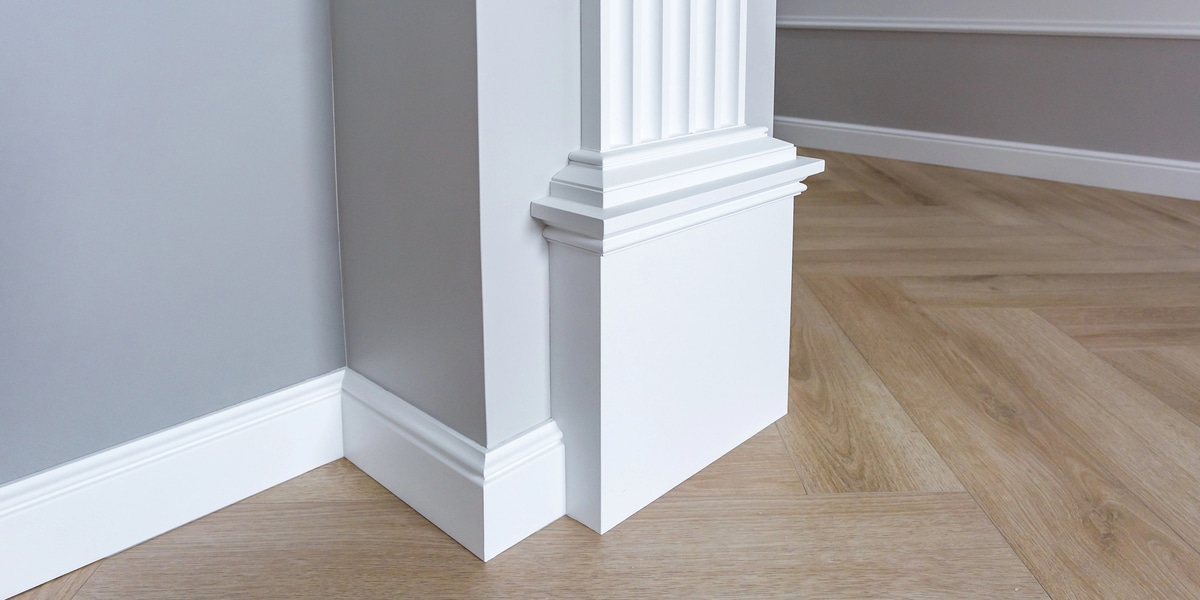The Complete Guide to Floor Moldings & Transitions (with Room-by-Room Diagrams)

Flooring transitions play a critical role in both design and functionality. They bridge gaps between rooms, connect different flooring materials, and allow hardwood flooring and other surfaces to expand and contract naturally. Properly installed floor transitions prevent tripping hazards, protect edges, and create a polished, finished appearance in every space. These elements are particularly important in homes that mix wood flooring, tile, vinyl, and carpet across multiple rooms.
Types of Floor Moldings
Base molding and wall trim form the visual frame around your floor. Baseboards typically range from 3 to 8 inches high and protect the lower portion of walls from scuffs, moisture, and vacuum impacts. Shoe molding and quarter-round trim fill small gaps where the floor meets the wall, helping to hide expansion spaces left during hardwood installation.
Room-to-Room Floor Transitions
Different types of floor transitions handle varying height levels and materials. T-moldings connect hardwood flooring of the same height, often used between rooms where identical materials meet. Reducer strips solve level changes between surfaces, such as thick wood flooring transitioning down to thinner vinyl or laminate. Threshold strips fit in doorways, creating a clean separation between wet areas and dry rooms, especially where tile and carpet meet.
Material and Finish Selection
When selecting materials for your floor transitions, match the type and finish of your existing flooring. The Janka hardness scale helps homeowners and contractors compare wood durability. For example, oak has a hardness rating of 1,290 while Brazilian walnut scores a dense 3,684. Always test stains and finishes in natural and artificial light before final application, as adhesive residue and grout color variations can alter how the final surface appears under different lighting conditions.
Installation Tips and Standards
Installers must leave a 1/4-inch expansion gap around room edges to accommodate seasonal wood movement. This prevents buckling during humidity changes. Use the right adhesive or fasteners depending on the transition type and subfloor material. For tile-to-wood transitions, apply flexible grout or silicone between materials to allow slight movement. Building codes generally limit height differences between connected floors to 1/4 inch for safety and accessibility.
Design Integration
Well-planned flooring transitions enhance both beauty and performance. In open layouts, consistent trim color and coordinated transition materials create smooth visual flow. In kitchens, bathrooms, and entryways, moisture-resistant transition strips protect vulnerable edges. Thoughtful selection and professional installation of moldings, adhesives, and grout ensure long-lasting, seamless floor connections that maintain stability and style throughout your home.
Understanding Molding Types: Base, Shoe, Cove, and More
In residential construction and remodeling, floor moldings and trims play a vital role in connecting floors and walls while protecting edges from damage. The right combination of profiles and materials improves both the appearance and durability of spaces such as living rooms, hallways, and stairs. Professional installers select molding types based on room design, flooring material, and transition needs to ensure a clean, polished finish.
Baseboard and Shoe Molding
Baseboards form the main trim where drywall meets the floor. Typically standing between 3 to 8 inches tall, they hide expansion gaps left during flooring installation and prevent scuff marks from vacuum cleaners and furniture. Homeowners often match baseboard material with laminate flooring or hardwood for visual consistency. Below the baseboard, shoe molding finishes the transition. Carpenters nail this thin ¾-inch strip directly to the floor rather than the baseboard. This technique allows the flooring to expand and contract beneath it without cracking the trim or pulling nails loose.
Quarter Round, Cove, and Scotia Moldings
Quarter round molding has a simple curved shape—like a dowel cut into four equal parts. It provides a soft, rounded finish along floor edges and works well in contemporary living rooms with clean design lines. Cove molding features a concave curve that softens the joint between walls and floors, popular in traditional and historic homes. Scotia molding blends both profiles with an uneven curve that fits irregular wall angles or non-standard baseboard thicknesses, making it ideal for complex floor layouts.
Transition Strips and Edge Profiles
Where flooring materials change between rooms, builders use transition pieces for safety and appearance. End caps finish exposed flooring edges near doorways, fireplace hearths, or sliding doors. A wood transition strip provides a seamless join between hardwood and laminate flooring, while an aluminum strip adds a durable, moisture-resistant edge in kitchens or entryways. Installers use a miter saw to cut perfect angles for tight-fitting corners and custom transitions, especially on stairs where precision is critical for both safety and aesthetics.
Finishing Details
After installation, small gaps between moldings and walls require sealing. Professionals use paintable caulk to create smooth transitions between trim and drywall, preventing dust and moisture from entering joints. This finishing step completes the visual connection between wall and floor while adding durability to high-traffic areas.
Room-by-Room Transition Strategies & Diagram Examples
Each room in your home requires specific floor transitions to handle changes in materials, moisture, and traffic flow. Proper flooring transitions make spaces look cohesive while maintaining durability and safety. The right approach prevents tripping hazards, supports expansion gaps, and gives your home a smooth visual flow between rooms.
Kitchen to Dining Room
Kitchens often combine tile flooring with hardwood or laminate in dining areas. A T-molding works best here, connecting the two materials while allowing each to expand and contract independently. These transition strips sit flush between surfaces, keeping floors even and preventing cracks where adhesive and grout meet.
Bathroom Thresholds
Bathrooms need moisture-resistant transitions because of frequent water exposure. A marble saddle strip or waterproof reducer piece seals the edge between tile and hallway flooring. This transition stops water from spreading beyond the bathroom, protecting wood or laminate in nearby spaces from swelling and damage.
Hallway Intersections
In large or open layouts, multiple flooring types often meet in one area. Multi-way transition strips connect up to three different materials, such as tile, wood, and vinyl. These specialized flooring transitions align rooms visually while absorbing small height differences between each surface.
Entryway Transitions
At home entrances, floor levels often change where outdoor tile or concrete meets interior wood flooring. A reducer molding bridges that gap, preventing a hard edge that could chip or cause tripping. This type of wood transition strip also shields interior floors from dirt and water tracked in from outside.
Smart Placement for Seamless Design
Proper transition placement ensures both comfort and longevity. Floor diagrams typically position transitions in the center of doorways or along walking paths to minimize wear. Installers measure the direction of foot traffic and use caulk where needed to seal edges cleanly against the drywall. Smart alignment keeps each floor connected, preventing uneven surfaces and maintaining a polished look across your home’s flooring system.
Material Selection, Profiles & Finish Matching
Choosing the Right Molding Material
Selecting the right molding material ensures a seamless connection between your floors and walls while maintaining structural balance. When working with hardwood flooring, always choose moldings made from the same wood species for consistency in texture and grain. Oak floors look best with oak moldings, and maple floors pair naturally with maple moldings. This approach keeps wood flooring visually unified across rooms. If an exact match isn’t available, select a wood type with a similar Janka hardness rating so both materials age and wear evenly over time. Matching hardness also prevents one surface from denting or wearing faster than the other, ensuring long-term durability.
Understanding Profile Types
Molding profiles serve different purposes based on how your floors connect or change elevation.
- T-moldings bridge two flooring surfaces of similar height, usually with a maximum difference of up to 1/4 inch. They’re ideal for smooth transitions between laminate flooring and tile or between living rooms and hallways.
- Reducer strips handle larger height changes over 1/2 inch, such as between hardwood floors and low-pile carpet. These create a gentle slope that eliminates tripping hazards.
- Threshold profiles work best at exterior doors where sealing against drafts and moisture is essential. Their raised edge provides a barrier against the weather while completing the visual transition between interior wood flooring and outdoor surfaces.
Matching Colors and Finishes
Color consistency is vital for creating a professional, polished look. Always test stain colors directly on the molding you plan to use—different wood species absorb stains differently, affecting undertones and overall hue. Once installed, fill nail holes with a matching wood filler to blend the repair seamlessly with the final finish. For faster installation, pre-finished moldings are available, though color variations can occur between batches. These differences are typically minor and remain within acceptable visual ranges, especially under varied lighting conditions.
Installation Best Practices, Codes & Maintenance Tips
Before beginning any molding installation, check that floor height changes comply with local building codes. Most regulations permit only up to 1/4 inch difference between surfaces without a sloped transition. This standard prevents tripping hazards and keeps floor transitions safe and comfortable to walk on.
Good trim work requires careful attention to several key areas:
Space for floor expansion
Always leave a 1/4-inch to 3/8-inch gap around the room’s edges when installing floating floors, such as laminate or engineered wood flooring. These floors naturally expand and contract with temperature and humidity changes. Baseboard molding hides the expansion gap while allowing the floor to move freely without buckling or warping.
Attaching methods
Proper attachment ensures stability and long-term performance. For wooden trim or baseboards, use a nail gun to secure each piece every 16 inches along the wall. This spacing provides consistent holding strength without splitting the wood. For metal or vinyl transition strips, flexible adhesive works best. The adhesive absorbs minor subfloor movement and prevents the molding from loosening over time.
Matching colors
Before staining or finishing, test your chosen wood stain on a small section of the actual molding inside the room. Lighting changes how colors appear, especially between natural sunlight and artificial bulbs. Testing ensures the final shade matches your hardwood flooring or laminate flooring tones.
Regular cleaning
Once installed, keep transition areas clean and well-maintained. Vacuum the channels and tracks beneath transition strips weekly to remove dust and debris that could scratch flooring surfaces. Use only manufacturer-approved cleaning products to preserve the adhesive, caulk, and finish quality.


















